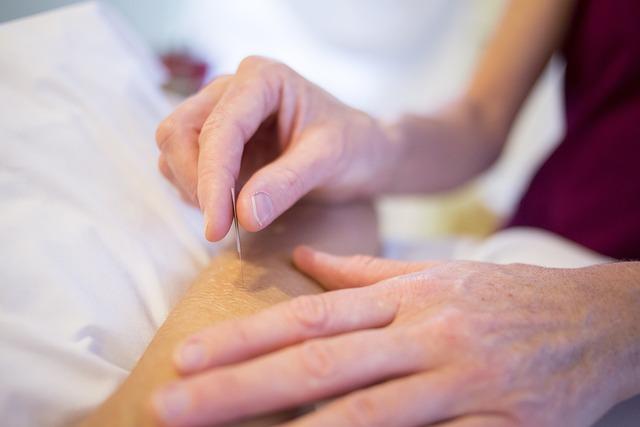In the tapestry of wellness practices that span centuries and continents, acupuncture emerges as a vibrant thread, weaving ancient wisdom with modern healing. This time-honored technique, rooted in Traditional Chinese Medicine, has captivated the curiosity of those seeking a holistic approach to health and pain relief. As needles gently puncture the skin, they unlock pathways of energy, offering a unique symphony of balance and restoration. In this exploration, we delve into how acupuncture not only alleviates discomfort but also harmonizes the body’s intricate systems, guiding us towards a more integrated and serene existence.
Understanding the Principles of Acupuncture and Holistic Healing
Acupuncture, an ancient practice rooted in Traditional Chinese Medicine, is grounded in the belief that the body is a complex network of energy pathways known as meridians. These pathways are believed to influence the body’s physical and mental health. By inserting fine needles into specific points along these meridians, acupuncture aims to balance the flow of Qi (pronounced “chee”), the vital life energy, thereby promoting healing and alleviating pain.
Holistic healing, on the other hand, takes a comprehensive approach to health, considering the interconnection between the mind, body, and spirit. Acupuncture complements this approach by addressing not just the symptoms, but the underlying causes of discomfort. Through this synergy, acupuncture can help in:
- Reducing stress and anxiety, which are often intertwined with physical ailments.
- Enhancing overall well-being by restoring energy balance.
- Improving sleep quality, leading to better mental and physical health.
- Boosting the immune system, aiding the body’s natural healing processes.

Exploring the Science Behind Acupunctures Pain-Relieving Effects
Acupuncture, an ancient practice rooted in Traditional Chinese Medicine, has garnered attention for its potential to alleviate pain through scientific mechanisms. At its core, acupuncture involves the insertion of thin needles into specific points on the body, known as acupoints. This practice is believed to stimulate the body’s natural painkillers and influence the central nervous system. Research suggests that acupuncture may promote the release of endorphins, the body’s natural opioids, which help in reducing pain perception.
Furthermore, acupuncture might modulate the brain’s response to pain and stress. Studies have shown that it can impact the activity of neurotransmitters such as serotonin and dopamine, which play a role in mood regulation and pain perception. Key scientific insights include:
- Neurotransmitter Release: Encourages the release of chemicals that alter pain transmission.
- Inflammation Reduction: May decrease inflammatory markers in the body.
- Nerve Stimulation: Potentially alters the nerve signaling pathways involved in pain processing.
While more research is needed to fully understand these mechanisms, acupuncture remains a promising complementary therapy for pain relief.

Integrating Acupuncture into a Comprehensive Wellness Plan
Incorporating acupuncture into your wellness routine can enhance your body’s natural healing processes. This ancient practice complements other therapeutic modalities by focusing on energy flow and balance. Acupuncture can be seamlessly integrated with various wellness strategies to support overall health and vitality.
- Personalized Approach: Tailor sessions to address specific health concerns, ensuring a unique experience for each individual.
- Stress Reduction: Regular acupuncture can significantly lower stress levels, promoting a sense of calm and relaxation.
- Pain Management: By targeting specific points, acupuncture can help alleviate chronic pain, reducing reliance on medication.
By combining acupuncture with other holistic practices like yoga, meditation, and nutrition, individuals can cultivate a more balanced and harmonious lifestyle. This synergy not only enhances physical health but also nurtures mental and emotional well-being.

Practical Tips for Choosing the Right Acupuncture Practitioner
Finding a skilled acupuncture practitioner is crucial for a successful holistic healing journey. Here are some practical tips to guide your selection process:
- Check Credentials: Ensure the practitioner is licensed and certified by relevant acupuncture boards. This guarantees they have undergone rigorous training and adhere to professional standards.
- Experience Matters: Look for a practitioner with substantial experience in treating conditions similar to yours. Their expertise can make a significant difference in the effectiveness of your treatment.
- Seek Recommendations: Personal referrals from friends or family can provide insights into the practitioner’s approach and patient care. Online reviews can also be a valuable resource.
- Assess Communication: A good practitioner should be able to clearly explain the treatment plan and address any concerns you may have. Effective communication fosters trust and comfort.
- Visit the Clinic: Pay attention to the cleanliness and ambiance of the clinic. A welcoming and serene environment can enhance your overall experience and relaxation.





